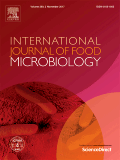Ver ítem
- xmlui.general.dspace_homeCentros Regionales y EEAsCentro Regional Mendoza - San JuanEEA MendozaArtículos científicosxmlui.ArtifactBrowser.ItemViewer.trail
- Inicio
- Centros Regionales y EEAs
- Centro Regional Mendoza - San Juan
- EEA Mendoza
- Artículos científicos
- Ver ítem
Biodiversity of Saccharomyces cerevisiae populations in Malbec vineyards from the “Zona Alta del Río Mendoza” region in Argentina
Resumen
The “Zona Alta del Río Mendoza” (ZARM) is the major Malbec grape viticulture region of Argentina. The aim of the present study was to explore Saccharomyces cerevisiae biodiversity in ZARM vineyards. Interdelta PCR and RFLP mtDNA molecular markers were applied to differentiate S. cerevisiae strains. The presence of commercial strains on ZARM vineyards was also assessed. Our results reveal a highly diverse, but genetically closely related, S. cerevisiae
[ver mas...]
The “Zona Alta del Río Mendoza” (ZARM) is the major Malbec grape viticulture region of Argentina. The aim of the present study was to explore Saccharomyces cerevisiae biodiversity in ZARM vineyards. Interdelta PCR and RFLP mtDNA molecular markers were applied to differentiate S. cerevisiae strains. The presence of commercial strains on ZARM vineyards was also assessed. Our results reveal a highly diverse, but genetically closely related, S. cerevisiae population (containing more than 190 molecular patterns among 590 S. cerevisiae isolates). According to the S. cerevisiae strain diversity found in vineyards, they were classified as vineyards with high and low polymorphic S. cerevisiae populations. Six vineyards showed a high polymorphic population, with more than 20 different S. cerevisiae molecular patterns. S. cerevisiae populations in these vineyards were diverse and irregularly distributed, with different strains in each vineyard site. Low polymorphic S. cerevisiae population vineyards displayed very low yeast diversity, with only 9 to 10 different S. cerevisiae strains and presence of two commercial strains widely distributed. Population diversity estimators were calculated to determine the population structure of S. cerevisiae in the ZARM vineyards. The obtained values support the hypothesis that the eight sampled subpopulations come indeed from a larger population.
[Cerrar]

Autor
Fuente
International Journal of Food Microbiology 151 (3) : 319-326 (December 2011)
Fecha
2011-12-15
Editorial
Elsevier
ISSN
0168-1605
Formato
pdf
Tipo de documento
artículo
Palabras Claves
Derechos de acceso
Restringido
 Excepto donde se diga explicitamente, este item se publica bajo la siguiente descripción: Creative Commons Attribution-NonCommercial-ShareAlike 2.5 Unported (CC BY-NC-SA 2.5)
Excepto donde se diga explicitamente, este item se publica bajo la siguiente descripción: Creative Commons Attribution-NonCommercial-ShareAlike 2.5 Unported (CC BY-NC-SA 2.5)

